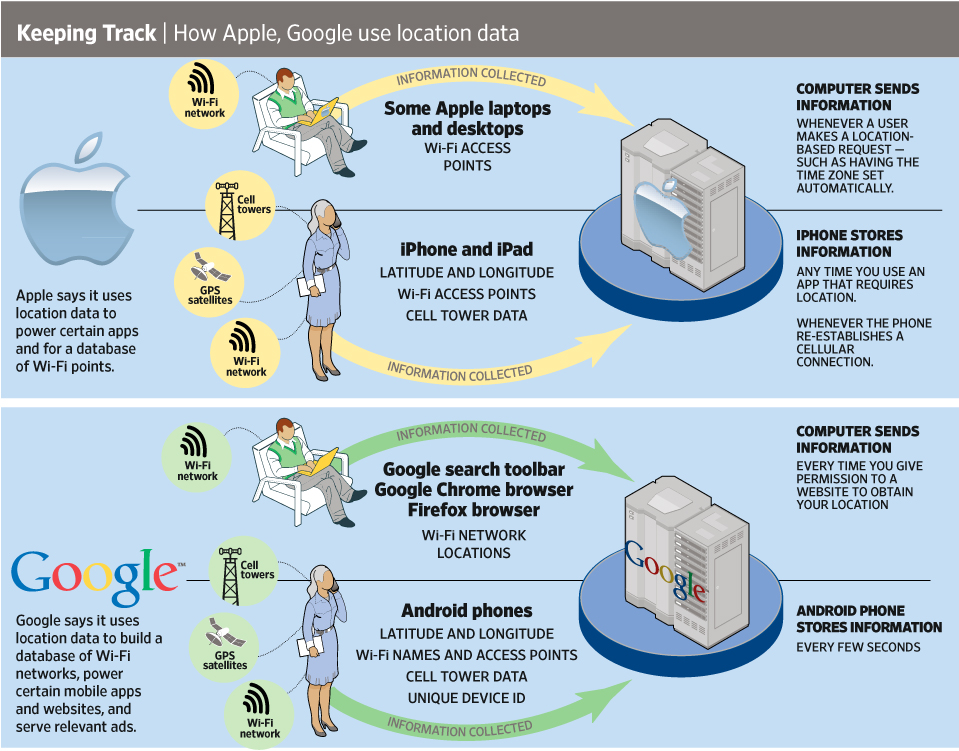http://online.wsj.com/article/SB10001424052748703778104576287401134790790.html
APRIL 27, 2011
Computers, Too, Can Give Away Location
By AMIR EFRATI And JENNIFER VALENTINO-DEVRIES
Google Inc. and Apple Inc. collect and store location information from personal computers, as well as mobile devices, according to company executives, a disclosure that sheds new light on the scope of the data collected by tech companies.
Apple gathers information from some Apple Macintosh computers connected to Wi-Fi networks, and Google collects data from Wi-Fi-connected computers that use Google's Chrome browser or search "toolbar."
They obtain the information after a computer scans the area around itself for available Wi-Fi networks, typically after users give a website permission to determine the computer's approximate location.
A description of the methods came in an interview with a Google product manager and a letter from Apple executives to federal lawmakers. Some of the information is laid out in Google's privacy policy.
In most cases, the companies ask users for permission before gathering information about users' wireless networks and nearby networks. But sometimes when they ask, it isn't clear exactly how the data will be stored and used. Some Apple computers send location information to Apple if a user asks the computer to use his location to automatically display the correct local time.
Both companies have said the data they collect are anonymous and aren't tied to specific users.
Last week, The Wall Street Journal reported that mobile phones using Apple and Google software regularly transmit their locations back to the companies.
On Tuesday, Sen. Al Franken (D., Minn.), chairman of the Senate Judiciary Subcommittee on Privacy, Technology and the Law, said the panel will hold a May 10 hearing on "Protecting Mobile Privacy," and invited representatives of both Apple and Google to attend.
Both companies use computer-location data to build highly precise databases of Wi-Fi networks, which they use, in turn, to locate phones and computers attached to those networks.
The information also can also be used to improve users' experience when they visit sites like Google Maps or the weather-forecasting site Foreca that allow users to request data tailored to their locations.
It isn't known whether Apple uses the data it collects for other purposes or whether it has made any changes recently in its tracking functions. Apple didn't respond to requests for comment.
Google also compiles the location data to help it target more-relevant ads to certain users when they access its search engine or other Google sites, said Steve Lee, a Google product manager, in an interview last year.
Google collects location information through software in its Chrome browser and its toolbar, which displays a Google search box on a Web browser so that a user doesn't need to go to Google's website to conduct a search.
The toolbar is included with many versions of browsers such as Microsoft Corp.'s Internet Explorer. It can also be installed by users on browsers such as Mozilla Corp.'s Firefox.
The collection process works differently in Internet Explorer 7 or 8 than in other browsers. On IE7 and IE8, when a user explicitly agrees to let a website such as Twitter obtain his location, his computer scans the area for nearby networks and passes the information, via the toolbar, to Google's location database to pinpoint the computer's location, a Google spokesman said.
Once the location feature is turned on, Google will periodically receive information from the computer when it scans the area for other wireless networks, the spokesman said, for the purpose of improving the quality of the Google location database. Information about nearby networks isn't provided to the websites that request users' location. The spokesman said the feature was launched in 2009.
Google Toolbar on Internet Explorer 9, the latest version of the browser, doesn't collect any location information.
In other browsers, including Firefox and Google's own Chrome, location collection is turned on only for brief periods when users give explicit permission to certain websites to find their location. At other times, the location-collection feature is turned off, the spokesman said.
Google says the collection process works like this: the computer scans the area around itself to find available Wi-Fi networks, and then the Google Toolbar or the Web browser sends the Wi-Fi access-point information back to Google's location database. Google "anonymizes" and aggregates the information.
Apple disclosed its location-gathering practices in a letter last year to Reps. Edward Markey (D., Mass.) and Joe Barton (R., Texas). According to the letter, Macintosh computers running the "Snow Leopard" operating system send the company information about a computer's location if the user is connected to the Internet through a Wi-Fi network and is using location-based services, such as asking the computer to automatically identify the local time zone.
The data is "collected anonymously, and is stored in a database accessible only by Apple," the letter said. Users can prevent the information from being collected by turning off "location services" in the "security" menu under "system preferences" on the computer, it said.
In its letter, Apple said it also obtains location data when users surfing the Web with Apple's Safari 5 browser allow an application, such as Google Maps, to find the computer's location. Users must grant permission for each request. Apple doesn't store the Wi-Fi information that is transmitted based on requests by websites, the letter said.
--Yukari Iwatani Kane and Spencer E. Ante contributed to this article.
Write to Amir Efrati at amir.efrati@wsj.com
